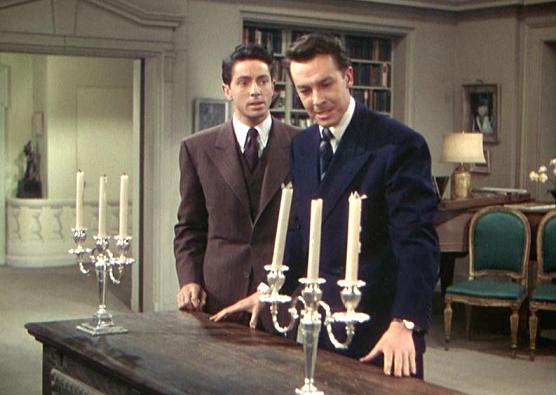| Fig. 1: Rope poster. |
| Fig. 2: Philip and Brandon strangle David. |
 |
| Fig. 3: Brandon decorates the chest. |
| Fig. 4: All party guests. |
By the end of the film, all party guests have left to try and find out what's happened to David, as they grow more and more concerned that he may have been in some kind of accident. It is when the housekeeper, Mrs. Wilson, nearly hands Rupert a hat with David's initials on, that Rupert knows for sure that David was in the apartment, prompting him to return to the apartment later, claiming he left his cigarette case. Rupert's return results in Philip's complete breakdown, as he is sure Rupert knows what he and Brandon have done. However, Philip is not entirely to blame for the two of them being found out, Brandon's behaviour throughout the evening has also been noticeably odd, with him pushing the subject of people of inferior intellect not being important, and therefore, deserving of having their lives cut short.
| Fig. 5: After Rupert's confrontation. |
 |
| Fig. 6: Mrs. Wilson clears the chest. |
 |
| Fig. 7: Rupert questions Philip. |
Rope was based on a 1929 play by Patrick Hamilton, and it does feel like a play. It is easy to picture it on stage, as all the main events happen in one room. Hitchcock shot the film in a series of long takes, moving from actor to actor, with a set that would be rearranged out of view so the camera equipment could fit; "He built elaborate sets with movable walls on wheels. He choreographed his actors so that they and the camera could perform intricate ballets without interrupting the action." (Ebert, 1984). Sometimes this is obvious, as objects seem to have moved when the camera shows a larger shot of the scene. Filming this way makes the audience feel more immersed in the events, as there is no switching between faces or room, but instead, what feels like a long, fluid event.
Images:
Figure 1. Rope Poster. (1948) [poster] At: http://www.dvdclassik.com/critique/la-corde-hitchcock (Accessed on: 12.01.16)
Figure 2. Philip and Brandon strangle David. (1948) From: Rope. Directed by: Alfred Hitchcock [Film still] United States: Transatlantic Pictures. At: http://www.dvdclassik.com/critique/la-corde-hitchcock (Accessed on 24.01.16)
Figure 3. Brandon decorates the chest. (1948) From: Rope. Directed by: Alfred Hitchcock [Film still] United States: Transatlantic Pictures. At: http://beermovie.net/2015/01/02/rope/ (Accessed on 24.01.16)
Figure 4. All party guests. (1948) From: Rope. Directed by: Alfred Hitchcock [Film still] United States: Transatlantic Pictures. At: http://www.cinemagraphe.com/rope-1948.php (Accessed on 24.01.16)
Figure 5. After Rupert's confrontation. (1948) From: Rope. Directed by: Alfred Hitchcock [Film still] United States: Transatlantic Pictures. At: http://creofire.com/rope-1948-analysis/ (Accessed on 24.01.16)
Figure 6. Mrs. Wilson clears the chest. (1948) From: Rope. Directed by: Alfred Hitchcock [Film still] United States: Transatlantic Pictures. At: https://theseventhart.files.wordpress.com/2010/04/rope.jpg (Accessed on 24.01.16)
Figure 7. Rupert questions Philip. (1948) From: Rope. Directed by: Alfred Hitchcock [Film still] United States: Transatlantic Pictures. At: https://thehitchcockproject.wordpress.com/category/week-33-rope-1948/ (Accessed on 24.01.16)
Bibliography:
Ebert, R. (1984) 'Rope' In rogerebert.com 15.06.1984 [online] At: http://www.rogerebert.com/reviews/rope-1948 (Accessed on: 25.01.16)
Hutchinson, P. (2012) 'My favourite Hitchcock: Rope' In: The Guardian 27.07.12 [online] At: http://www.theguardian.com/film/filmblog/2012/jul/27/my-favourite-hitchcock-rope (Accessed on: 25.01.16)
Crowther, B (1948) 'Rope (1948)
THE SCREEN IN REVIEW; ' Rope,' an Exercise in Suspense Directed by Alfred Hitchcock, Is New Bill at the Globe' 27.08.1948 [online] At: http://www.nytimes.com/movie/review?res=980DE3D81630E03BBC4F51DFBE668383659EDE (Accessed on: 25.01.16)
Unknown (2010) 'Archive for the ‘Week 33: ‘Rope’ – 1948’ Category' 19.08.10 [online] At: https://thehitchcockproject.wordpress.com/category/week-33-rope-1948/ (Accessed on: 25.01.16)

Excellent review Eleanor :)
ReplyDelete